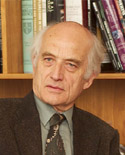The Revd Dr Geoffrey Cook, former Vice-Master of St. Edmund’s College, was previously a member of the Scientific Staff of the Medical Research Council from 1986-2004, heading a research team in developmental neurobiology in the Department of Anatomy, Cambridge University from 1979-2004. Dr Cook was the first to describe the presence of sugars on the external surfaces of cell membranes, a completely novel concept at the time of this discovery, leading to a ground-breaking series of three first-author papers in Nature within the space of two years [Nature 188, 1011-1012, 1960; Nature 191, 44-47, 1961; Cook, G. M. Nature 195, 159-161, 1962]. Dr Cook remains an Affiliated Lecturer in the University of Cambridge.
Dr Cook was ordained deacon in the Catholic Church in 1978; is a member of the Society for Ordained Scientists; Chairman of the Ecumenical Commission (from 2005 Commission for Dialogue and Unity), Diocese of East Anglia; Member of the Standing Committee, former Chairman of Cambridgeshire Ecumenical Council; former Member of the Committee for Christian Unity, Catholic Bishops’ Conference of England & Wales; Governor of Ipswich School, Ipswich, Suffolk; and LEA Governor (and Vice-Chairman 2003 – to date) of St Bede’s Interchurch Comprehensive School, Cambridge.
Recent Publications
- Kuan, K. C-Y, Tannahill, D, Cook, G.M.W. & Keynes, R.J. (2004) Somite polarity and segmental patterning of the peripheral nervous system. Mech. Development 121,1055-1068.
- Vermeren, M.M., Cook, G.M.W., Johnson, A.R., Keynes, R.J. & Tannahill, D. (2000) Spinal nerve segmentation in the chick embryo: analysis of distinct axon-repulsive systems. Developmental Biology 225, 241- 252.
- Keynes, R.J., Tannahill, D., Morgenstein, D.A., Johnson, A.R., Cook, G.M.W. & Pini, A. (1997) A surround repulsion of spinal sensory sensory axons in higher vertebrate embryos. Neuron 18, 889-897.
- Keynes, R.J. & Cook, G.M.W. (1996) Axon guidance molecules. Cell 83,161-169.
- Cook, G.M.W. (1995) Glycobiology of the cell surface: The emergence of sugars as an important feature of the cell periphery. Glycobiology, 5, 449-458.




